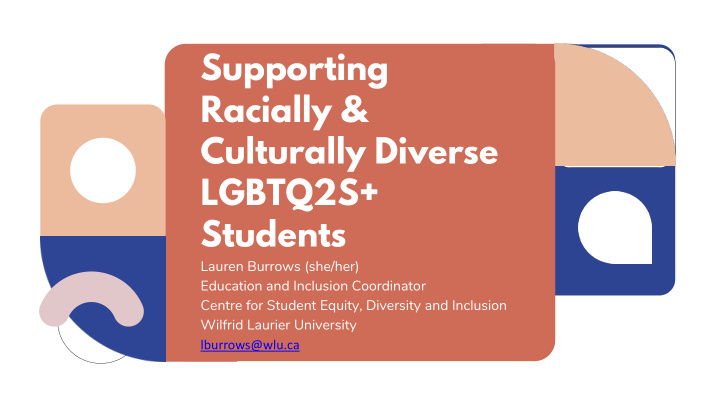



Supporting Racially & Culturally Diverse LGBTQ2S+ Students Lauren Burrows (she/her) Education and Inclusion Coordinator Centre for Student Equity, Diversity and Inclusion Wilfrid Laurier University lburrows@wlu.ca
Expectations • High Level and Experiential and Limitations • Avoid 'Columbusing' (Jones & Okun, 2001) • Challenge the utility of terms such as Racially Diverse, Racialized, Culturally Diverse and LGBTQ2S+
Engagement Complete a personal Intrapersonal 'environmental scan'. Questionaire Cognitive Bias Catalogue how bias may CHECK OUT: impact your perceptions, and decision-making http:// process. unistoten.camp/ supportertoolkit/ Contributions Commit to sustainable, tangible contributions to issues you know impact students.
• Resist acclimatization to white western dominant spaces (code By and For switching, managing fragility (DiAngelo, 2011), centering Spaces whiteness etc.). • Build community and capacity. Examples: QTPOC Collective, Caucusing, • Create opportunities to address Training, Communities of lateral violence free from Practice & Advisory dominant gaze. Committees. • Allow for sustainable cross- movement organizing.
• Request for students with experiential knowledge or expertise to sit on university committees, working groups and taskforces. Strategies For • Source facilitators, educators, counsellors Barriers to that can facilitate by and for spaces and support ways to respond to harm within Supporting By diverse spaces and For • Create multi-campus/multi- university/cross-sector opportunities to Spaces build larger communities. • Create strategic plans and terms of references that require a recognition of cross-movement organizing and the necessity of caucusing .
• Address lack of representation and Networks of employment equity. Culturally- • Address gaps in student support service provision. Specific • Address gaps in racial and cultural Supports literacy (Winddance Twine, 2006); Provide a stop-gap when there are Example: Curriculum disruptions to a 'culture of learning’ such Developers, Counsellors, as paternalism or conflict avoidance Educators, Student Affairs (Jones & Okun, 2001). Practitioners, Chaplains, • Connect students with mentors to Experiential/WIL Learning support a sustainable Partners, Mentors etc. professionalization pipeline
• Attend community events with the goal of building relationships before they are needed. (Facebook, Eventbrite, Cold-Call) Strategies For • Provide a template for practicums, Barriers to placements, co-ops, external contractors etc. to ensure their policies, procedures, practices, Creating values, qualifications etc. align with equity, diversity and inclusion (EDI) priorities; Ensure Networks of off-site supervision is equipped to identify and respond to structural and interpersonal Culturally oppression. Specific • Work towards employment equity and ethical service agreements. If this is not available, Supports create a list of resources in an act of mutual aid that you can offer to internal/external partners who may provide support to you or your students.
Example: Focusing programming solely on mainstream pride celebrations, or experiences of oppression, trauma or disenfranchisement. • Disrupt attempts to depoliticize student experiences (Lindo, 2017). • Create opportunities for micro-validations outside of Divest from mainstream discourses. Celebration/ • Focus on the documentation of diverse histories including the ways in which communities innovate, Deficit Binary create social change, process trauma, use local knowledges etc. • Supporting student advocacy; create a culture of change-making
Strategies for Address Barriers to Moving Away from a Celebration/Deficit Binary • Share intersectional and dynamic stories; respond to issues impacting racially and culturally diverse communities on LGBTQ2S+ platforms. • If there are barriers to documenting institutional/organizational history, develop programs to work with mediums to document institutional memories that do not require academic rigor or are vulnerable to censorship (e.g. visual art, poetry). • Develop skills training in which students do not have to manage environmental stress; trauma-informed, anti-oppressive etc. • Source a training for all students to respond to racist and unjust discourses that align with wise practices in freedom of expression.
Example: Lack of representation within research, service provision, community resources; Overrepresentation in experiences and responses to violence. Mitigate • Address lack of inclusion in institutional landscape (Lindo, 2017). Hypervisibility • Decrease surveillance of students and student advocacy. and • Support institution-wide racial and cultural Hyperinvisibility literacy. • Create opportunities of justice (e.g. economic justice in paid opportunities for students).
Strategies to Address Challenges with Visibility • Develop a working institutional definition of racism that includes intersection of race, culture, gender and sexuality. • Develop an unofficial response team that will mitigate the burden on student to respond and diffuse threats to individual safety. • Partner with appropriate resources to complete institutional research on these experiences within your institution or locality.
Thank You! Get in touch with Lauren lburrows@wlu.ca
Recommend
More recommend